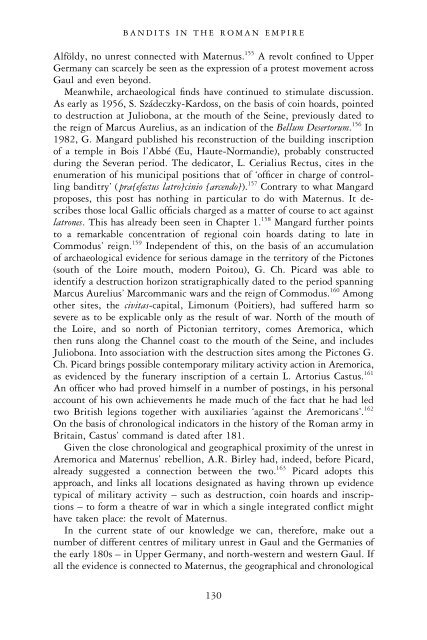You also want an ePaper? Increase the reach of your titles
YUMPU automatically turns print PDFs into web optimized ePapers that Google loves.
BANDITS IN THE ROMAN EMPIRE<br />
Alföldy, no unrest connected with Maternus. 155 A revolt confined to Upper<br />
Germany can scarcely be seen as the expression of a protest movement across<br />
Gaul and even beyond.<br />
Meanwhile, archaeological finds have continued to stimulate discussion.<br />
As early as 1956, S. Szádeczky-Kardoss, on the basis of coin hoards, pointed<br />
to destruction at Juliobona, at the mouth of the Seine, previously dated to<br />
the reign of Marcus Aurelius, as an indication of the Bellum Desertorum. 156 In<br />
1982, G. Mangard published his reconstruction of the building inscription<br />
of a temple in Bois l’Abbé (Eu, Haute-Normandie), probably constructed<br />
during the Severan period. The dedicator, L. Cerialius Rectus, cites in the<br />
enumeration of his municipal positions that of ‘officer in charge of controlling<br />
banditry’ ( pra[efectus latro]cinio [arcendo]). 157 Contrary to what Mangard<br />
proposes, this post has nothing in particular to do with Maternus. It describes<br />
those local Gallic officials charged as a matter of course to act against<br />
<strong>latrones</strong>. This has already been seen in Chapter 1. 158 Mangard further points<br />
to a remarkable concentration of regional coin hoards dating to late in<br />
Commodus’ reign. 159 Independent of this, on the basis of an accumulation<br />
of archaeological evidence for serious damage in the territory of the Pictones<br />
(south of the Loire mouth, modern Poitou), G. Ch. Picard was able to<br />
identify a destruction horizon stratigraphically dated to the period spanning<br />
Marcus Aurelius’ Marcommanic wars and the reign of Commodus. 160 Among<br />
other sites, the civitas-capital, Limonum (Poitiers), had suffered harm so<br />
severe as to be explicable only as the result of war. North of the mouth of<br />
the Loire, and so north of Pictonian territory, comes Aremorica, which<br />
then runs along the Channel coast to the mouth of the Seine, and includes<br />
Juliobona. Into association with the destruction sites among the Pictones G.<br />
Ch. Picard brings possible contemporary military activity action in Aremorica,<br />
as evidenced by the funerary inscription of a certain L. Artorius Castus. 161<br />
An officer who had proved himself in a number of postings, in his personal<br />
account of his own achievements he made much of the fact that he had led<br />
two British legions together with auxiliaries ‘against the Aremoricans’. 162<br />
On the basis of chronological indicators in the history of the Roman army in<br />
Britain, Castus’ command is dated after 181.<br />
Given the close chronological and geographical proximity of the unrest in<br />
Aremorica and Maternus’ rebellion, A.R. Birley had, indeed, before Picard,<br />
already suggested a connection between the two. 163 Picard adopts this<br />
approach, and links all locations designated as having thrown up evidence<br />
typical of military activity – such as destruction, coin hoards and inscriptions<br />
– to form a theatre of war in which a single integrated conflict might<br />
have taken place: the revolt of Maternus.<br />
In the current state of our knowledge we can, therefore, make out a<br />
number of different centres of military unrest in Gaul and the Germanies of<br />
the early 180s – in Upper Germany, and north-western and western Gaul. If<br />
all the evidence is connected to Maternus, the geographical and chronological<br />
130


